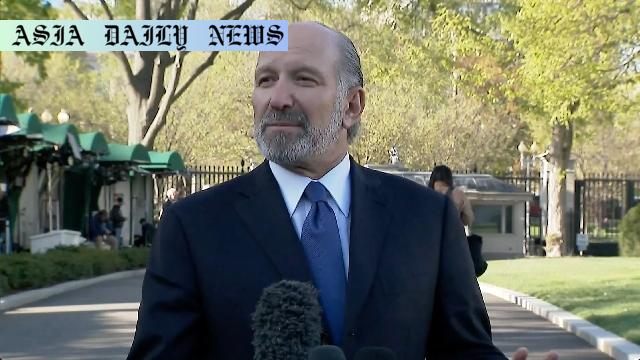Trade Agreement: Senior officials from the US and China meet, agreeing on a framework to ease economic tensions and lift rare earths restrictions.
Trade Agreement: US and China signed a deal aimed at easing trade tensions.
Rare earth export restrictions and semiconductor trade were focal points.
US will lift restrictive measures, while China reviews applications for exports.
Agreement aims to foster better economic communication between the two powers.

Introduction: The Landmark US-China Trade Agreement
The United States and China recently took a significant step toward mitigating escalating trade tensions by signing a pivotal trade agreement. This agreement, finalized following negotiations in London earlier this month, seeks to address contentious trade imbalances and disputes. Both nations have experienced deteriorating trade relations in recent years, notably due to restrictions related to rare earth metals and semiconductor-related items. With this agreement, both Washington and Beijing have demonstrated their commitment to fostering better relations and ensuring smoother economic engagements.
The Core Elements of the Trade Agreement
A central focus of the deal lies in the export restrictions that have plagued critical industries. Beijing’s control of rare earth metals plays a dominant role in global supply chains, while Washington’s stringent restrictions on semiconductor exports have created a ripple effect in tech industries worldwide. As per the agreement, China will now review and approve export applications for rare earths in accordance with its laws. In return, the US has agreed to lift certain restrictive measures imposed against China. These efforts reflect a bid to ensure smoother operations in industries that form the backbone of global technological advancements.
Implications for Global Trade
The agreement holds significant implications not just for the US and China but for the global economy as well. By addressing critical disputes, such as access to rare earth materials and the supply of semiconductors, the deal marks a step toward stabilizing supply chains worldwide. Furthermore, it signals a potential warming of relations between the two superpowers, which could lead to enhanced cooperation on other pressing issues. Market leaders and analysts are optimistic that this agreement will restore confidence among investors and companies reliant on consistent trade flows between these nations.
Future Prospects and Challenges
While this agreement paves the way for progress, it does not entirely resolve all issues between the two nations. Ongoing discussions and negotiations will remain necessary, particularly as trade relations are deeply interwoven with geopolitical factors. Some critics argue that the framework lacks specificity and may falter in implementation. However, the regular communication channels established between Washington and Beijing could act as a stabilizing mechanism. Both sides appear willing to collaborate, aiming for a future where contentious trade practices give way to mutual benefit.
Conclusion: A Positive Step Forward
The trade agreement between the United States and China represents a positive step toward navigating one of the most complex economic relationships in the world today. Through this framework, the two nations demonstrate a shared commitment to addressing mutual concerns and reducing economic friction. If implemented effectively, this agreement could have far-reaching impacts, benefiting both economies and fostering stability in the global market. Nevertheless, the road ahead remains uncertain, and only time will tell whether the deep-seated issues can be resolved in their entirety.
Commentary
The Significance of the US-China Trade Deal
The recently announced trade agreement between the United States and China is a noteworthy achievement that underscores the importance of diplomatic discourse in a globally interconnected economy. For years, tensions between these two economic superpowers have fueled uncertainty in international markets, particularly in industries heavily reliant on rare earth metals and advanced semiconductors. This pact is a much-needed signal of hope for stakeholders across these pivotal industries who have faced disruptions and escalating costs as a direct result of these trade disputes.
Balancing Geopolitics and Economics
What stands out about this deal is its dual focus on addressing specific trade challenges while simultaneously paving the way for improved bilateral relations. Rare earth metals and semiconductor-related exports are not merely economic commodities; they are strategic assets in a world increasingly driven by technological advancements. By negotiating terms to ease restrictions, both nations are ensuring that their respective industries can continue to innovate and compete on a global scale. This balance between geopolitics and economics poses a delicate challenge but is a necessary step for fostering stability.
Optimism with Caution
While the agreement marks a positive development, it is crucial to approach it with cautious optimism. History shows that trade agreements often face hurdles during implementation. Political shifts, potential disagreements in execution, and unresolved secondary issues could hinder the intended outcomes of this framework. Despite these concerns, the establishment of structured communication and negotiation processes between Washington and Beijing is a promising development, reducing the likelihood of abrupt policy changes or retaliatory actions.
Conclusion: A Step in the Right Direction
In summation, the US-China trade agreement is a commendable achievement that reflects a conscious effort on both sides to address long-standing issues. While challenges remain, this development illustrates that dialogue and cooperation can yield constructive outcomes, even amidst complex geopolitical dynamics. The global economy will undoubtedly benefit from a reduction in trade tensions, and this agreement sets a foundation upon which future progress can be built. As such, it represents a beacon of possibility in the ongoing quest for economic collaboration and stability.


